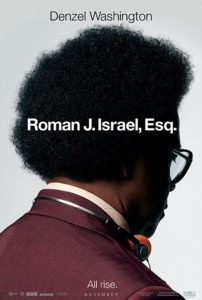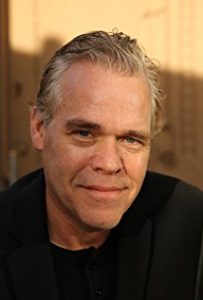 In Dan Gilroy’s dramatic thriller, Roman J. Israel, Esq., a civil rights-minded defense attorney (Denzel Washington), recruited by a wealthy cutthroat lawyer (Colin Farrell), fights to keep his ideals as he fights for justice in the Los Angeles criminal court system.
In Dan Gilroy’s dramatic thriller, Roman J. Israel, Esq., a civil rights-minded defense attorney (Denzel Washington), recruited by a wealthy cutthroat lawyer (Colin Farrell), fights to keep his ideals as he fights for justice in the Los Angeles criminal court system.
Because Roman was not the typical “square-jawed” leading man, during pre-production, Washington and the director explored the character extensively. Production designer, Kevin Kavanaugh, assembled Roman’s apartment in the production office to assist in character development.
“All the props were set-up so Washington could inhabit the space and climb into who his character was,” said editor John Gilroy. “It’s a tricky thing to have a main character with his attributes. I think he took a really big leap, finding who and what Roman was. Danny’s script was a great blueprint for the story, but really it was not until Denzel started inhabiting that character that we all discovered who he was.”
Because so much work had been done in pre-production, once shooting began, a lot of takes were not necessary. Although the editor was available for consultation before production, it was when footage started rolling in that he was “all over it,” building the picture. As a testament as to how good the screenplay was, the structure of the story did not change much in post-production.
“The greater the script, the less you have to mess with the story,” stated Gilroy. “With Danny’s movie there was not a lot of cutting room rewriting, which can happen on a movie. If the blueprint is good, it makes everything smoother. You’re not trying to find the story when you are shooting.”
As an editor, Gilroy looked closely at the film, mining the nuance to find the magic. With a film like this, the scenes were fragile constructs of emotion and character interactions. On every film Gilroy follows the same process, but when working with his brother there is a shared sensibility, “It’s easy for me to read him.”
As the title signals, the movie is about Roman J. Israel. On some level he is loveable, but not always likeable. The main challenge in the editing was “tracking Roman.” It was a balancing act making him as fascinating as possible to watch, even with his awkwardness and tendency to say the wrong thing.
The casting of talented actors made Gilroy’s job much easier. “Colin Farrell is such a professional, on-the-money actor. Carmen [Ejogo] was a great actress in any scene. I was blown away by the dinner scene and the way she was able to get herself into the emotion she needed to make that scene pay off with Roman,” commented Gilroy. “I’m always looking for the magic. These actors tended to bring a lot of magic themselves.”

Gilroy dealt a lot with sound and music. To get the cut looking and feeling like a movie as fast as possible, he added sound design, creating a “scale model” of where sound elements will be in the finished film. Having worked with supervising sound editor Margit Pfeiffer on Nightcrawler, a shorthand had been established. Gilroy could send a sub-edit to the sound crew, who would “make it great,” then send it back to him to incorporate into the picture edit. That kept the film evolving.
Gilroy rarely cuts to music, preferring to find the natural rhythm of each movie. Composer James Newton Howard wrote a suite of themes for the film before shooting commenced. The music was “so right on,” that they used those themes while finessing the edit. The suite was a great “jumping off point” for the direction of the final score. Along with Washington, who is a music officiado, music editor Del Spiva helped shape the source cues that played a big part in defining Roman’s character as someone stuck in the 70s.
Gilroy noted there are a handful of films in his career where “the planets align” with the right cast, the right script, and the right magic happening on set. This film was one of them. He felt the civil rights backdrop of the film resonated in the current environment, sending a message without being preachy. He’s proud about how well the film turned out, making it one of his favorite movies, “I love it. I love the movie. What can I say?”





